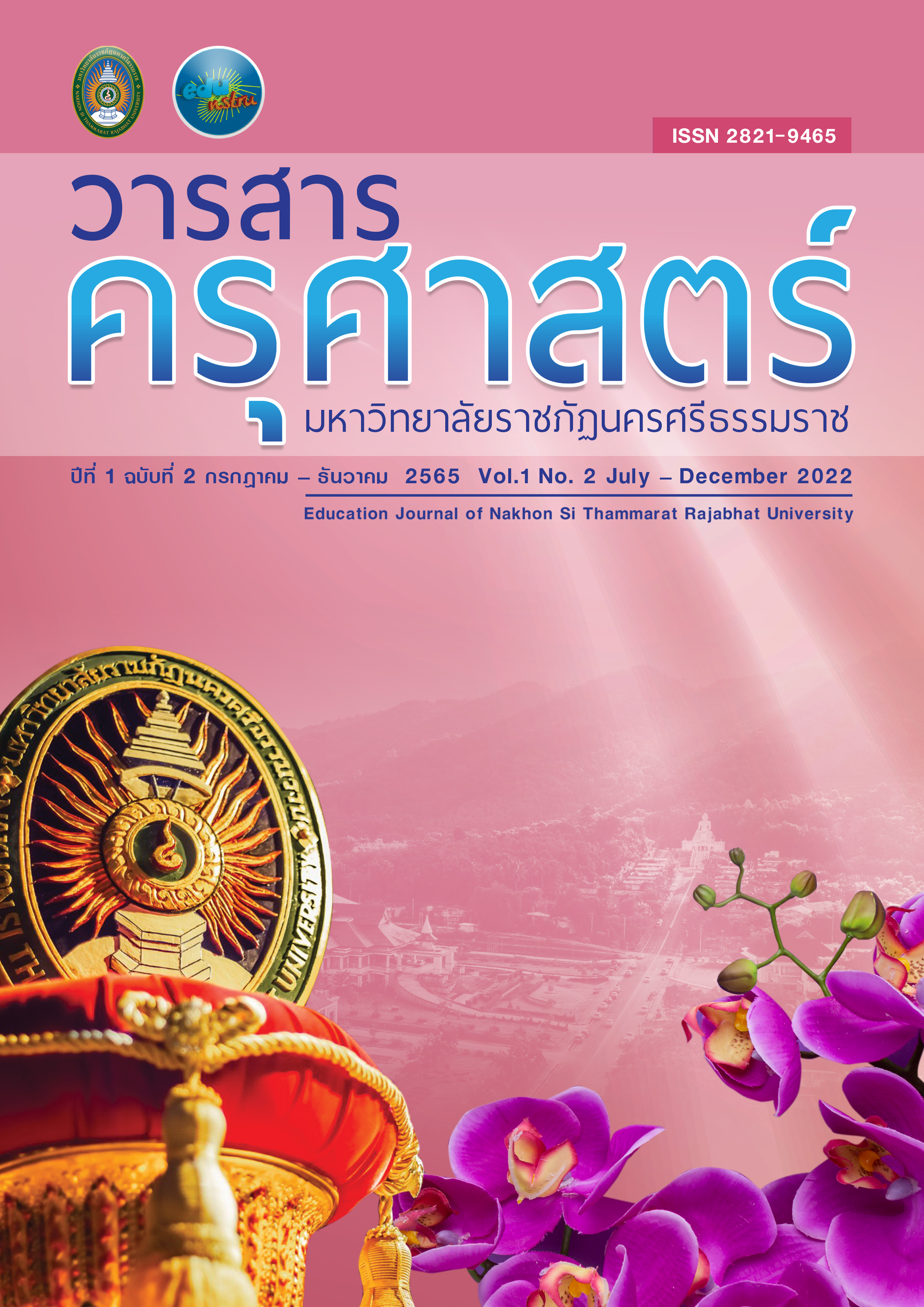The Development of Mathematics Problem-Solving Skill Packages on Sequences and Series of Matthayomsuksa Six Students at Petcharik Demonstration School under Nakhon Si Thammarat Municipality
Main Article Content
Abstract
The purposes of this research were: 1) to develop the mathematics problem-solving skill packages on sequences and series according to standardized criteria of 75/75, 2) to compare the achievement of student between before and after learning through the packages, 3) to assess the mathematics problem-solving skill on sequences and series and 4) to study Matthayomsuksa six students’ satisfaction on learning through the mathematics problem-solving skill packages on sequences and series. The sample was 33 students studying in M.6/1 in the first semester of 2021 educational year. The sample was selected by means of simple random sampling. The researcher employed the one-group pretest-posttest design and the research instruments were as follows: 1) the mathematics problem-solving skill packages on sequences and series, 2) the achievement test on sequences and series, 3) the evaluation form on the mathematics problem-solving skill and 4) the questionnaire on students’ satisfaction towards learning through the mathematics problem-solving skill packages on sequences and series. The statistical devices were percentage, mean, standard deviation and t-test.
The results of this research were as follows: 1) The mathematics problem-solving skill packages on sequences and series had the efficiency of 82.47/80.51 2) Matthayomsuksa six students learning through the packages showed their mathematics problem-solving skill after learning higher than before learning at .05 level of significance. 3) Matthayomsuksa six students’ mathematics problem-solving skill on sequences and series was at high level. and 4) Matthayomsuksa six students’ statisfaction on learning through the mathematics problem-solving skill packages on sequences and Series was at a very high level.
Article Details

This work is licensed under a Creative Commons Attribution-NonCommercial-NoDerivatives 4.0 International License.
บทความที่ได้รับการตีพิมพ์เป็นลิขสิทธิ์ของวารสารครุศาตร์ มหาวิทยาลัยราชภัฏนครศรีธรราช
ข้อความที่ปรากฏในบทความแต่ละเรื่องในวารสารวิชาการเล่มนี้เป็นความคิดเห็นส่วนตัวของผู้เขียนแต่ละท่านไม่เกี่ยวข้องกับวารสารครุศาสตร์ มหาวิทยาลัยราชภัฏนครศรีธรรมราช
References
กระทรวงศึกษาธิการ. (2560). หลักสูตรแกนกลางการศึกษาขั้นพื้นฐาน พุทธศักราช 2551 (ฉบับปรับปรุง พ.ศ. 2560). กรุงเทพฯ: โรงพิมพ์ชุมนุมสหกรณ์การเกษตรแห่งประเทศไทย.
ชฎาพร ภูกองชัย. (2561). การพัฒนาแบบฝึกทักษะคณิตศาสตร์ เรื่อง อัตราส่วนและร้อยละ สำหรับนักเรียนชั้นมัธยมศึกษาปีที่ 2. วารสารโครงงานวิทยาการคอมพิวเตอร์และเทคโนโลยีสารสนเทศ มหาวิทยาลัยราชภัฏมหาสารคาม, 4 (2), 93-101.
ชานนท์ ปิติสวโรจน์. (2557). การจัดการเรียนรู้เพื่อพัฒนาผลสัมฤทธิ์ทางการเรียนคณิตศาสตร์โจทย์ปัญหาการบวกและการลบโดยใช้กระบวนการแก้ปัญหาของโพลยา สำหรับนักเรียนชั้นประถมศึกษาปีที่ 2.วารสารบัณฑิตวิจัย มหาวิทยาลัยราชภัฏเชียงใหม่, 8(1), 57-69.
นงลักษณ์ ฉายา. (2558). การพัฒนาแบบฝึกทักษะคณิตศาสตร์ เรื่อง การบวกและการลบเศษส่วน สำหรับนักเรียนชั้นมัธยมศึกษาปีที่ 1 โรงเรียนบ้านยาง “คุรุราษฎร์รังสรรค์” [วิทยานิพนธ์ปริญญาคุรุศาสตร มหาบัณฑิต สาขาวิชาหลักสูตรและการสอน มหาวิทยาลัยราชภัฏบุรีรัมย์].
มุทิตา กฤชอาคม. (2561). การพัฒนาผลสัมฤทธิ์ทางการเรียนจากการใช้แบบฝึกทักษะคณิตศาสตร์ เรื่อง การแก้โจทย์ปัญหาเกี่ยวกับสมการเชิงเส้นตัวแปรเดียวของนักเรียนชั้นมัธยมศึกษาปีที่ 1 [วิทยานิพนธ์ปริญญาศึกษาศาสตรมหาบัณฑิต สาขาวิชาคณิตศาสตร์ศึกษา มหาวิทยาลัยรามคำแหง].
โรงเรียนสาธิตเทศบาลวัดเพชรจริก. (2564). แบบสรุปผลสัมฤทธิ์ทางการเรียน ชั้นมัธยมศึกษาปีที่ 6 ปีการศึกษา 2562-2563 งานวัดและประเมินผลการศึกษา กลุ่มบริหารงานวิชาการ โรงเรียนสาธิตเทศบาลวัดเพชรจริก. นครศรีธรรมราช: เทศบาลนครนครศรีธรรมราช.
สุคนธ์ สินธพานนท์. (2553). นวัตกรรมการเรียนการสอนเพื่อพัฒนาคุณภาพของเยาวชน. กรุงเทพฯ: 9119 เทคนิคพริ้นติ้ง.
อมินตา หลุมนา. (2563). การพัฒนาความสามารถในการแก้ปัญหาทางคณิตศาสตร์ตามแนวคิดของโพลยาร่วมกับแบบฝึกทักษะ เรื่อง ทศนิยมและเศษส่วน ของนักเรียนชั้นมัธยมศึกษาปีที่ 1 [วิทยานิพนธ์ปริญญาครุศาสตรมหาบัณฑิต มหาวิทยาลัยราชภัฏมหาสารคาม].
Maslow, A. H. (1954). Motivation and Personality. New York: Harper and Brother. Polya, G. (1957). How to Solve it. New York: Doubleday & Company.

